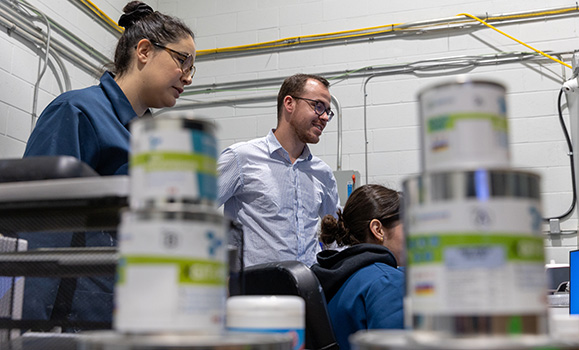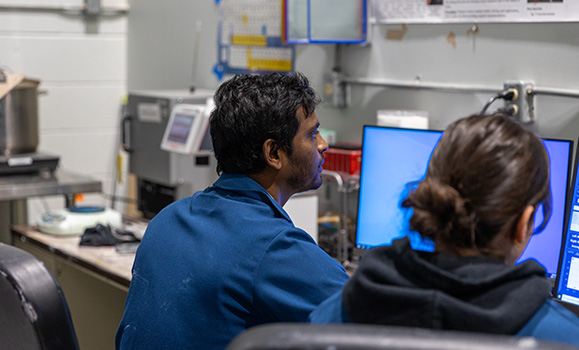The Snapshot
Dalhousie grads Mo AlGermozi and Marciel Gaier aim to upend the global marine coatings industry with Graphite Innovation & Technologies (GIT), a business helping to decarbonize global shipping that finds its origin as one of the first startups through the university’s Emera ideaHUB.
The Idea
 When AlGermozi and Gaier met for a dinner one night in 2014, the purpose was to determine if common ground existed between their respective research topics.
When AlGermozi and Gaier met for a dinner one night in 2014, the purpose was to determine if common ground existed between their respective research topics.
Back then, both were material engineering students at Dalhousie. AlGermozi was working on a project involving graphene, the thinnest known material, and one of the strongest, while Gaier was exploring technologies to reduce wear and tear on aerospace coatings. The pair quickly spotted the potential to link their areas of interest.
“It was a perfect match,” AlGermozi recalled during an interview at his office at The Bays, Invest Nova Scotia’s facility for technology-based startups in Dartmouth, Nova Scotia.
The Challenge
The result of their partnership is GIT, which has developed marine anti-fouling coatings that are ultra-smooth, durable, and capable of improving the fuel efficiency of commercial vessels such as cargo ships and tankers.
Within GIT’s suite of technologies are topcoats and primers specifically formulated — with up to 50 separate ingredients, including graphene—for use on different hulls and propellers. In each case, the goal is to ensure the vessel moves as smoothly and efficiently through the water as possible.
“At a high level, we're trying to really make an impact through reducing fuel consumption on vessels,” AlGermozi explains. “When the vessel is moving through the water, less drag means the engine isn’t working as hard, which means there's a lot less fuel burned. We’re also trying to show vessel owners that it's time to move on to high performance coatings that do not leach or harm our oceans.”
The Solution
The company has secured investment from several strategic sources, including from the investment arm of the Stolt-Nielsen shipping company and from prominent Nova Scotia entrepreneur, investor and Dal supporter John Risley, who is among the company’s largest shareholders.
Before investing, Risley asked to have GIT’s paint applied to one of his boats so he could test it for himself, even in icy conditions. He was evidently impressed, contributing to all three of GIT’s funding rounds, including the most recent Series A round that netted $10.2 million. The round was led by BDC Capital’s Climate Tech Fund and Invest Nova Scotia also contributed.
AlGermozi and Gaier met Risley through the Creative Destruction Lab – Atlantic hosted at Dalhousie, where Risley is a founding partner and mentor. “That's when things got a lot more exciting,” AlGermozi recalls of the company’s experience in CDL, where budding companies benefit from mentorship and investment from established entrepreneurs and business owners.
 Marciel Gaier and his team analyse product data.
Marciel Gaier and his team analyse product data.
Gaier echoed the point: “The Creative Destruction Lab was really helpful because it connected us to the entrepreneurship side of things. For me, it bridged the gap from technical knowledge to learning how to scale up, and how to use the resources available. That's quite important.”
GIT was also one of the first companies to emerge from the Emera ideaHUB, Dalhousie’s incubator geared to support early-stage technology startups in building physical products. GIT took part in the ideaBUILD and ideaBRIDGE programs, which helped them create the initial prototypes of their coatings, and then build a path toward commercialization.
“Dalhousie has a lot of resources in terms of entrepreneurship,” AlGermozi adds. “The ideaHUB provided us from the start with a place to operate from. We were two students and they provided us with funding for prototyping, resources, mentorship, and just overall exposure to the industry. Dal definitely got our name out there. Spinning out of a university is a big thing.”
AlGermozi and Gaier have remained connected to the ideaHUB, sitting on its advisory committee, speaking at events, and volunteering on judging panels.
The impact
By the end of 2023, GIT will have supplied coatings for over 150 vessels globally. The company has also signed supply agreements with some of the industry’s key shipowners, including Stolt Tankers and others in Europe and Singapore.
GIT is growing, with more than 30 employees hailing from nearly 20 different countries.
It will soon boost its production six-fold by building a new 25,000 square foot, state-of-the-art facility in Dartmouth, funded in part by a $950,000 loan from the Atlantic Canada Opportunities Agency. The new plant will be capable of manufacturing one million litres of paint per year, enough to coat more than 500 large commercial vessels. In a recent development the company partnered with Halifax Transit to apply graphene-based coatings to the hull and propeller of the Rita Joe ferry, helping to accelerate Halifax’s commitment to becoming a net-zero carbon neutral economy by 2050.
“The world is changing,” AlGermozi said. “There's a lot of legislation coming into effect that will make vessel owners liable for the CO2 emissions they are creating. But this industry is very old and vessel owners are always concerned about the bottom line. They don't want to change. We’ve introduced a new concept that can help them make that change.”
GIT is also leveraging of the Mitacs Accelerate intership program, facilitated at Dalhousie via the Office of Commercialization and Industry Engagement, which allows engineering, master’s, and PhD students to conduct research with industry. In late 2023, GIT had ten graduate students conducting research related to marine coatings.
“They get paid and they get the industrial experience,” Gaier says while sitting in his office, located near the company’s testing and production area, where he oversees R&D.
 GIT employee at work.
GIT employee at work.
“A lot of people that finish graduate degrees don't have a lot of industrial experience. That's a challenge both for the industry and for those graduates. It's very hard for anyone to hire you, even though you have a PhD, if you have zero experience working in the field. This program is quite unique because it allows students to gain industry experience while working on applied research and topics that are useful for solving societal problems. In our case that’s reducing the GHG emissions of ships."

